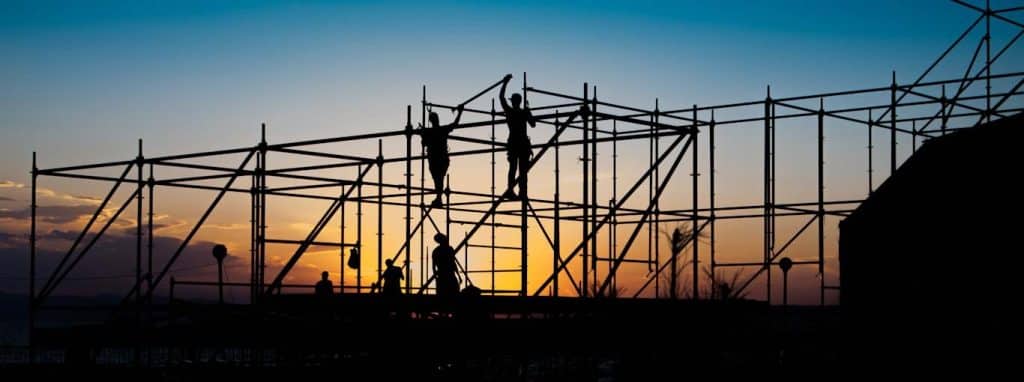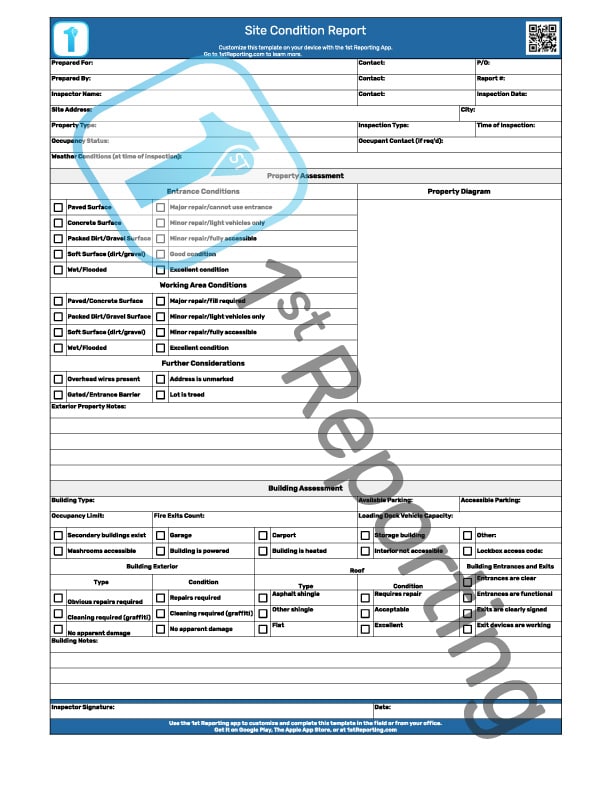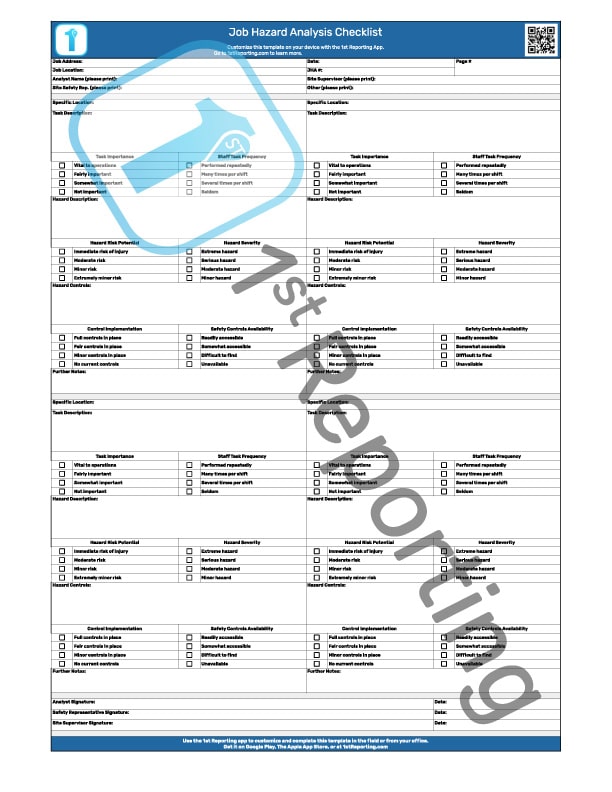A construction safety checklist is vital because safety is no joke for any construction site workplace. You know tight deadlines and inclement weather can easily sway site crews to make poor safety decisions. So, using a Construction Site Safety Checklist like the one is critical to maintaining safe daily operations.
A Construction Safety Checklist (like the free downloadable template here) is essential for documenting daily site safety inspections and audits on construction job sites. The checklist streamlines the process and ensures that all aspects of the inspection are recognized and documented.
Let’s take a deep dive into the checklist and review the sections. We will also look at best practices for use so you get the most out of the process. We’ll even include some great tips for managing your daily construction site safety inspections. These will help with more efficient and effective reporting, so stick with us.
What’s Inside Our Comprehensive Workplace Safety Checklist
The Construction Site Safety Checklist breaks down into two pages and twelve sections. We’ll briefly examine each section so you’re best equipped to utilize this downloadable template.

The number in the bottom right of the template notes the template page numbers. You will find the following sections on page one of the Construction Site Safety Checklist.
- Administrative Checklist Information
- General Site Safety
- Personal Protective Equipment
- Occupational Health and Environmental Controls
- Signs and Barricades
- Electrical Systems
Administrative Checklist Information
The administrative checklist section includes text blocks for your inspector to input:
- name
- contact information
- site manager name
- site manager contact information
- site location
- date and time of the inspection
General Site Safety
The General Site Safety section of the Construction Site Safety Checklist includes statements about reporting. It also includes:
- communications
- site entrance
- exterior barrier or fencing
- general training.
The concept here is that your inspector only checks those statements they find true. But, we’ll learn how to use this checklist in the field further in this document, following the checklist explanation we’re in the middle of here.
Personal Protective Equipment
In the Personal Protective Equipment Section, you will find statements regarding the generally accepted minimum PPE requirements for most general construction sites. You may have specific requirements beyond those mentions, but we’ll address how to deal with those later in this document.
The PPE section includes the latest PPE requirements. It includes sanitizer and face masks for personnel working in proximity, indoors, or other local regulatory requirements regarding the spread of COVID-19 or other illnesses. The PPE section also includes a statement regarding the on-site training personnel have completed. It leads us to the inevitable conclusion that an easily accessible collection of training documentation should be on-site and readily available for your inspector.
In the United States in 2019, the total number of deaths from work accidents topped 5,000 (5,333, to be more precise). However, about 20% were in the construction industry. That means that 1 in 5 deaths at work was at construction sites. This section of the Construction Site Safety Checklist will hopefully help keep your workers better protected so they won’t become one of the 1 in 5. (source)
Occupational Health and Environmental Controls
Construction sites have several environmental and occupational health hazards, as you know. The Occupational Health and Environmental Controls section of the downloadable template provides a series of statements to ascertain the effective mitigation strategies taken on-site to preserve the health and safety of personnel. The section also includes topics from waste removal to adequate on-site washroom facilities.
Signs and Barricades
Signage and barricading hazards are vital regulatory requirements. Signs warn visitors and site personnel alike of dangers and the PPE that must find used. As an essential step to the safety inspection at the construction site, reviewing the signage and barricades implemented via the statements we have included in the downloadable template will aid your inspector is not missing any critical signage or barricading requirements.
Electrical Systems
Most construction sites deal with power in one form or another. The potential for electrical incidents increases when sites use generators, temporary hook-ups, and things like extension cords to power construction equipment. As such, it is critical to include a basic safety inspection of electrical systems during the construction site safety audit.
Let’s move on to page 2.
You’ll find the following remaining sections on page two of the Construction Site Safety Checklist.
- Fire Protection
- Material Handling
- Scaffolding, Raised Platforms, and Fall Protection
- Cranes and Hoists
- Vehicles and Powered Equipment
- Excavations, Concrete, and Masonry
- Sign-Off
Fire Protection
Construction sites have a variety of fire hazards as you are aware. Depending on the type of construction, there may be multiple forms of combustibles, flammables, or even explosive materials and chemicals on site.
The Fire Protection section of the downloadable template provides a series of statements about the on-site fire suppression systems. It also includes fire prevention procedures and training of personnel in related topics.
Material Handling
Material handling is a major logistical issue for most construction site project managers. Many materials, such as concrete, are time and environment dependant, so timing and safety are crucial. Unfortunately, sometimes construction workers rush due to timing, which can cause accidents. Therefore, we’ve included some vital statements in the material handling section. These will ensure the general safety of personnel regarding material handling issues. And again, you may find that your site has specialized items not included in the statements on the downloadable template. Not to worry, we’ll address the customization requirements later in this document.
Scaffolding, Raised Platforms, and Fall Protection
In 2020, OSHA found that the number one cited standard violated by industry was the construction industry and the violation of Fall Protection. (source)
Many construction sites have workers performing at heights on scaffolding, raised platforms such as scissor lifts, aerial boom lifts, or other powered equipment. The best way to prevent violations is through education. Ensuring your staff is well protected by being well educated on the dangers of falling.
This section of the downloadable template focuses on preventing fall hazards by addressing common concerns with scaffolding, raised platforms, and fall protection.
Cranes and Hoists
Look at any city skyline, and you’re bound to see a crane. Cranes and hoists are ubiquitous on construction sites and pose various hazards. The Cranes and Hoists section of the Construction Site Safety Checklist addresses common safety concerns with cranes and hoists. The section allows your inspector to address these issues during the safety audit.
Vehicles and Powered Equipment
No construction site is complete without powered equipment and vehicles. Whether it’s using forklifts and telehandlers for material handling, dump trucks for fill, or a grader, powered equipment is a vital part of today’s construction process. And with this big machinery comes big hazards.
The Vehicles and Powered Equipment section of the Construction Site Safety Checklist provides a series of statements your inspector can answer. It’s to ascertain the general safety conditions regarding vehicles and powered equipment on the job site.
Excavations, Concrete, and Masonry
Excavations, concrete, and masonry are quite different, but we’ve included them in the last section of the Construction Site Safety Checklist for your convenience. The two primary concerns are falling, crushing, and exposure hazards.
The statements provided in this section of the downloadable template allow the inspector to understand the essential safety protocol on-site. This knowledge aids in mitigating dangers to personnel from excavations, concrete use, and similar hazard-creating scenarios.
Sign-Off
The final section of the safety audit template for construction sites includes a basic sign-off. Make sure both the inspector and site manager sign and date the form for full compliance.
How To Use The Construction Site Safety Checklist
Now that you understand the sections of the two-page Construction Site Safety Checklist let’s talk for a moment on how to use the downloadable template best.
The concept of the Construction Site Safety Checklist (CSSC) is to provide statements in the form of true concepts. The inspector will check off each statement as true or leave it blank if not. Furthermore, the report should also include photos or videos of unacceptable items. These could be on the inspector’s smartphone or another device. Although, we do have an inspection reporting solution for including the photos or video with the template that you can learn more about here.
We recommend the following process to use this downloadable construction site safety inspection template.
The Process
- Download the printable PDF template.
- Print the template and make enough copies for each day of your project.
- Distribute the copies to your designated site safety inspector(s).
- Perform a daily inspection of the site prior to commencing work.
- Analyze the report daily for issues and resolve safety concerns immediately.
These basic steps will see you through a basic construction site safety audit procedure. We recommend doing the inspection daily, but local legislation may require a different scenario, so be sure to check with local laws about your state or province’s construction site safety inspection requirements.
Many of the statements on the document refer to supplementary documents. For example, these might include a vehicle inspection report or a safety harness daily inspection. These documents must be completed independently of the construction site safety audit and should be a part of your personnel’s daily routines on site.
If you don’t want to keep all of your different reports in different places, on different sheets of paper, we have a solution for you here. It’s a (mobile) digital reporting solution available on Google Play and The Apple App Store. We’ll talk a little more about it in the next section about the customization of the checklist.
How To Customize The Construction Site Safety Checklist
If your job site has customized statements you want to include in the Construction Site Safety Checklist, you have two options.
Option One
First, you can create your own supplementary page with statements to add to the printed two-page document. However, consider the evolving nature of job site requirements these days and you may find the second solution to be your best option.
Option Two (Preferred)
Stop messing around with papers, printers, ink, personnel’s handwriting, lost paperwork, filing cabinets, and all the other expenses to your budget and time that go with printed documents. Instead, increasing your company efficiency by switching to a mobile form automation solution is the best option.
Our society is rapidly changing due to technology. And it doesn’t have to be a frightening or expensive adjustment – not when it comes to construction site safety audits or other reporting requirements. From vehicle inspection forms to daily COVID-19 declarations, your company can say goodbye to the inefficiencies of paper reports and move into the digital cloud-based ecosystem.
To learn more about our mobile reporting solution, click here.
3 Essential Tips To More Efficient Construction Site Safety Inspection Reporting
Have a designated site safety inspector for your project.
Ensuring that you have a single individual accountable for the daily safety inspections is important. It ensures that they are not only familiar with the site but also maintain their accountability.
Therefore, accountability is spread out when multiple inspectors are in place for a single site. As each inspector subliminally relaxes, knowing the other inspector could catch something they miss. With a single inspector, there is no fallback. And thus, the inspector will feel more accountable for completing their inspection thoroughly.
Always have the appropriate personnel conducting the construction site safety audit.
Ensure they do so with the most up-to-date certifications and training to ensure compliance with your company’s policies, industry practices, or national regulations.
There is always one person at a company that must maintain constant training and that’s your safety inspector. Remember, don’t view their role as an expense.
Look at it as saving because losing a life on a construction site isn’t just devastating for those immediately affected. It generally costs the construction company exponentially more than the cost of a well-trained safety inspector who values a job well done.
Use a mobile reporting solution to automate construction site safety inspection reporting for ease of use and efficiency.
We’ve worked tirelessly to build and test a secure solution for managers just like you. We’ve listened to what industries tell us they need in a reporting solution. The culmination of our experience shines through in our mobile reporting app you can download today on Google Play or The Apple App Store.
Ready to take your site’s safety to the next level? Download our checklist now or click here to learn more about our mobile reporting solution.






